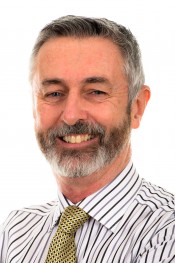Insects 'no replacement for marine diet'

AN article published in the National Geographic magazine this week, stating that insects are a more environmentally friendly diet for salmon than fish, is ‘out of date and incorrect’, according to IFFO, the Marine Ingredients Organisation.
The article, titled ‘Why Salmon Eating Insects Instead of Fish is Better for Environment’, published on February 5, discusses fishmeal and fish oil replacement in salmon feed by a Netherlands based company.
IFFO director general Andrew Mallison (pictured) said that although his organisation agrees with the need for additional feed options in aquaculture to ensure industry growth, ‘the total replacement of fishmeal and fish oil, as called for in this article, is unjustified and damaging to the fish farming industry’.
He issued a statement, saying: ‘The practice of feeding fish to fish is labelled as both inefficient and unsustainable in the article, but I would argue that responsibly sourced and used strategically, fishmeal and fish oil are both an efficient and sustainable feed choice. ‘
He pointed out that UN figures show stocks of wild capture fisheries are steady and not declining, thanks to better management.
‘While catches of some small pelagic species used to produce fishmeal and fish oil are volatile, this is due to environmental fluctuation, with permitted catches being varied in line with biomass abundance to protect the stocks.
‘These small pelagic species are often not as palatable, spoil quickly and are less popular compared to other local fish, but can be turned into highly nutritious feed.’
And he said that more than 45 per cent of the global production of fishmeal and fish oil is now independently certified as being safe and environmentally responsible.
Regarding the efficiency of the use of fishmeal and fish oil, the latest Fish In: Fish Out (FIFO) ratios show a conversion rate of 1kg of wild fish used in feed creates 1.22kg of farmed salmon, ‘demonstrating that farmed salmon now produce globally more consumable protein than is used in feed’.
‘This ratio is significantly lower than the out-of-date figures quoted in the article and shows how fishmeal and fish oil are now being more strategically used at key points in aquaculture production cycles, with a trend towards optimising their nutritional contributions,’ said Mallison.
‘In fact, looking at the FIFO ratio misses the rationale for the inclusion of fishmeal and fish oil in feeds as their contribution to growth and health of farmed fish goes well beyond the supply of mere protein and energy.’
Some 35 per cent of fishmeal is now produced from recycled by-product and waste from fish processing, he added.
‘Fishmeal and fish oil are rich in many of the micronutrients that are required for health, many of which are classed as essential.
‘Even reducing levels of fishmeal in feeds has resulted in feed companies having to supplement with specific materials that are both costly to produce, and carry their own environmental impacts.
‘Removing fishmeal as an ingredient to feed could therefore compromise the health of the fish and close an environmentally friendly way of recycling waste products.’
Furthermore, fishmeal and fish oil production does not require the same levels of freshwater for irrigation, treatment with agricultural chemicals such as fertilisers and pesticides, or use land needed to grow crops.
‘While insect meal may be a theoretical alternative, the production of the millions of tonnes needed to replace fishmeal is currently not viable.
‘The reality is that there is an opportunity for alternative ingredients like insect meal without needing to displace fishmeal.’

